Knowing when fruits are in season can make a significant difference in your culinary experience. The flavors are at their peak, the textures are delightful, and the nutritional value is unmatched. Plus, buying fruits that are in season is often more affordable and supports local farmers.
That’s why I’m here to guide you through the wonderful world of seasonal fruits with our comprehensive when fruits are in season chart. Whether you’re looking for citrusy delights in winter or juicy berries in the summertime, our fruit season calendar has got you covered.
Key Takeaways:
- Knowing when fruits are in season helps you enjoy the freshest and most flavorful produce.
- Buying locally sourced fruits supports local farmers and reduces the environmental impact of transportation.
- Use our when fruits are in season chart to know which fruits are available during each month of the year.
Benefits of Eating Seasonal Fruits
Eating seasonal fruits has numerous benefits. Firstly, you get to enjoy fruits at their peak flavor and nutritional value. When fruits are in season, they are harvested at the perfect time, ensuring optimal taste and freshness. This means that you can savor the natural sweetness and juiciness of fruits like strawberries, watermelons, or peaches, enhancing your overall eating experience.
Eating seasonal fruits also allows you to reap the maximum nutritional benefits. Fruits that are picked when they are fully ripe are richer in essential vitamins, minerals, and antioxidants. For example, ripe summer berries are packed with antioxidants that can protect your body against oxidative stress and inflammation.
“Eating seasonal fruits at their peak can provide a more enjoyable and nutritious eating experience.” – Health & Wellness Expert
Another advantage of opting for seasonal fruits is their affordability and abundance. When fruits are in season, the local supply is abundant, resulting in lower prices. You can enjoy your favorite fruits without breaking the bank, making healthy eating more accessible for everyone. Plus, supporting local farmers by choosing locally sourced, in-season fruits contributes to your community’s economic sustainability.
In addition to personal benefits, eating fruits that are in season also has a positive impact on the environment. When you choose seasonal produce, you reduce the need for long-distance transportation and storage, which contributes to lower carbon emissions. By reducing the environmental footprint, you’re playing your part in creating a more sustainable food system.
To help you make the most of the fruit availability by season, you can refer to a fruit ripening chart or fruits in season by month guide. These resources provide valuable information about which fruits are at their best during different times of the year. By planning your grocery shopping and meals based on the fruit availability, you can ensure that you always have a variety of delicious and nutritious seasonal fruits to enjoy.
The Benefits of Eating Seasonal Fruits:
- Enjoy fruits at their peak flavor and nutritional value.
- Affordable and abundant, making healthy eating accessible for everyone.
- Support local farmers and contribute to the community’s economic sustainability.
- Reduce the environmental impact of transportation and storage.
Now that you understand the benefits of eating seasonal fruits, let’s explore the wide variety of fruits available during each month of the year. Discover the flavors and possibilities that each season brings!
Fruits in Season by Month
Different fruits are in season during different months of the year. In general, citrus fruits like oranges and lemons are available in winter, berries and stone fruits like strawberries and peaches are abundant in summer, while apples and pears are harvested in the fall. Use a fruit seasonality chart or fruit harvest calendar to know which fruits to buy and when to find them at their best.
Here is a comprehensive guide to the fruits that are in season each month:
| Month | Fruits in Season |
|---|---|
| January | Grapefruit, Lemons, Oranges |
| February | Oranges, Pears, Pineapples |
| March | Kiwis, Mangoes, Strawberries |
| April | Blueberries, Lemons, Pineapples |
| May | Apricots, Cherries, Mangoes |
| June | Blackberries, Peaches, Strawberries |
| July | Blueberries, Cherries, Watermelons |
| August | Melons, Peaches, Plums |
| September | Apples, Grapes, Pears |
| October | Cranberries, Pears, Pumpkins |
| November | Apples, Persimmons, Pomegranates |
| December | Clementines, Grapefruits, Pomegranates |
By referring to a fruit seasonality chart or fruit harvest calendar, you can plan your grocery shopping and meals accordingly, ensuring that you enjoy the freshest, most flavorful fruits each month.
Incorporating Seasonal Fruits Into Your Diet
Seasonal fruits are not only delicious but also add variety and color to your meals. Whether enjoyed on their own as a healthy snack or incorporated into your recipes, these fruits can elevate the flavors of your dishes and provide essential nutrients. Here are some creative ways to incorporate seasonal fruits into your diet:
- Add berries to your morning cereal or yogurt: Start your day with a burst of sweetness and antioxidants by adding fresh or frozen berries to your favorite breakfast staples. They not only elevate the taste but also provide a nutritional boost.
- Use sliced apples or pears in salads: Crisp and juicy apples or pears can add a refreshing element to your salads. Their natural sweetness complements the savory ingredients and adds a delightful crunch.
- Make fruit-infused water for a refreshing drink: Hydrate yourself with a naturally flavored drink by infusing water with slices of citrus fruits, berries, or cucumbers. It’s a refreshing and healthy alternative to sugary beverages.
If you’re looking for more inspiration on incorporating seasonal fruits into your meals, refer to a seasonal fruits and vegetables chart. This chart provides insights into the availability and best pairing options for different fruits and vegetables. Experimenting with new combinations can add excitement to your meals and help you discover delicious flavor profiles.
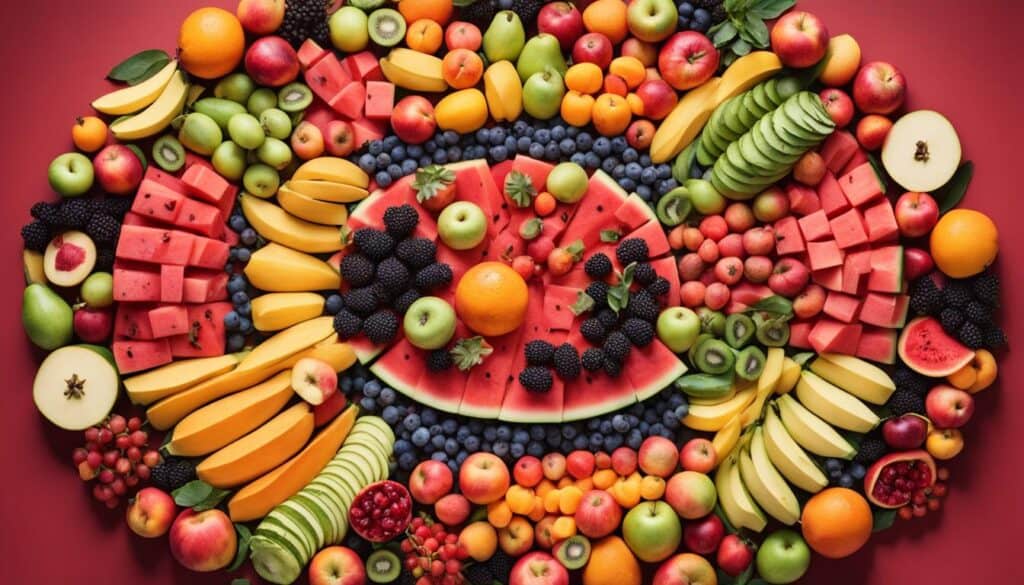
Shopping Tips for Seasonal Fruits
When shopping for seasonal fruits, I always keep in mind a fruit buying guide to make sure I choose the best produce. Here are some helpful tips to ensure that you get the freshest and most flavorful fruits:
- Look for firm and vibrant fruits: Opt for fruits that are firm to the touch and have a vibrant color. This indicates that they are ripe and ready to be enjoyed.
- Check for a pleasant aroma: A good way to determine the freshness of fruits is by smelling them. They should have a pleasant and sweet aroma, indicating their ripeness and flavor.
- Avoid bruised or overly soft fruits: Be sure to avoid fruits with bruises, cuts, or signs of decay. Overly soft fruits may also be overripe and lacking in flavor.
- Stay away from mold spots: Mold spots on fruits are a clear sign of spoilage. It’s best to choose fruits that are clean and free from any signs of mold or fungus.
If possible, I recommend buying your seasonal fruits from local farmers’ markets or grocery stores that label the source of their produce. This ensures that you are getting the freshest and most locally sourced fruits available. Plus, shopping for seasonal produce supports local farmers and promotes sustainability.
Remember, the key to enjoying the best flavors and nutritional benefits of seasonal fruits is to choose ripe and fresh produce. By following these shopping tips, you’ll be able to select the finest fruits to incorporate into your meals and snacks.
Sourcing Locally for Freshness and Sustainability
When it comes to shopping for seasonal produce, buying from local farmers’ markets or stores that prioritize local sourcing is an excellent choice. Not only does this support local farmers and the community, but it also ensures the freshness and quality of the fruits you purchase. By reducing the distance traveled for the produce, you’re also minimizing the carbon footprint associated with transportation.
Local growers often take pride in providing the best fruits that are in season, and you’ll have the advantage of knowing exactly where your fruits come from. The personal connection between the growers and the consumers adds a special touch to your shopping experience and allows you to learn more about the different varieties of fruits available.
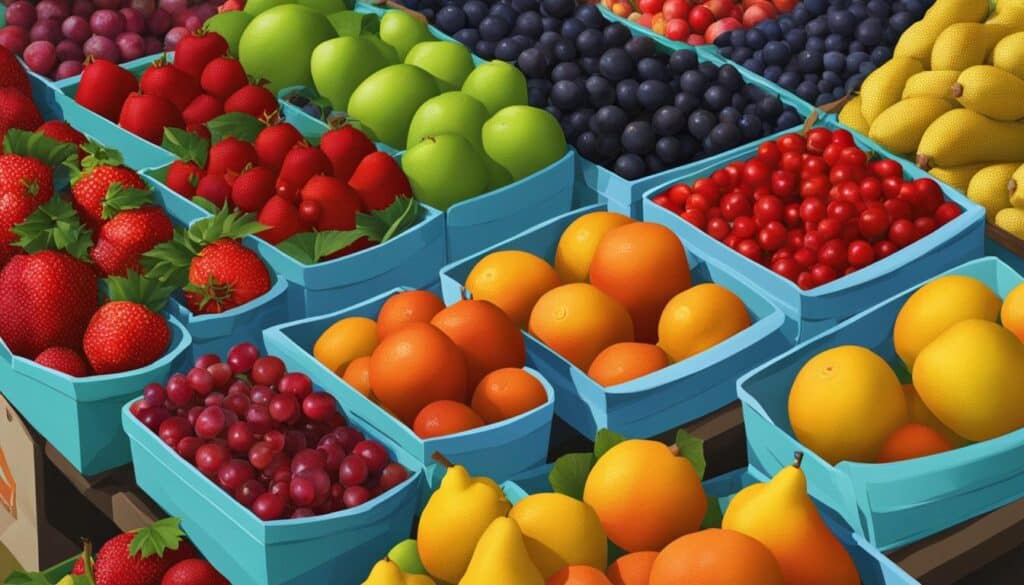
With all these shopping tips in mind, you’ll be well-prepared to select the freshest and most delicious seasonal fruits. Now, let’s explore some strategies for incorporating these seasonal delights into your daily diet.
Enjoying Seasonal Fruits All Year Round
While certain fruits may only be available during specific months, there are ways to enjoy them year-round. One option is to preserve seasonal fruits by freezing or canning them. Freezing berries, sliced fruits, and citrus zest allows you to enjoy them in smoothies, baked goods, or as toppings. Canning fruits like peaches or apples can provide you with delicious homemade jams and preserves that can be enjoyed throughout the year.
Not sure which fruits are best for freezing or canning? Here’s a table to help you out:
| Fruit | Freezing Technique | Canning Technique |
|---|---|---|
| Strawberries | – Remove stems and wash strawberries – Pat them dry and spread them on a baking sheet lined with parchment paper – Freeze until firm, then transfer to freezer bags or containers | – Wash and slice strawberries – Add them to sterilized mason jars – Prepare a syrup with sugar and water, and pour it over the strawberries – Place lids and rings on the jars, then process them in a water bath canner |
| Peaches | – Bring a pot of water to a boil – Make a small “X” on the bottom of each peach – Blanche the peaches in boiling water for about 30 seconds, then transfer them to an ice bath – Remove the skins, pit, and slice the peaches – Place them on a baking sheet lined with parchment paper, then freeze until firm and transfer to freezer bags or containers | – Peel, pit, and slice peaches – Add the peaches to sterilized mason jars – Prepare a syrup with sugar and water, and pour it over the peaches – Place lids and rings on the jars, then process them in a water bath canner |
| Apples | – Peel, core, and slice apples – Toss the slices in lemon juice to prevent browning – Place the slices on a baking sheet lined with parchment paper, then freeze until firm and transfer to freezer bags or containers | – Peel, core, and slice apples – Add the apple slices to sterilized mason jars – Prepare a syrup with sugar and water, and pour it over the apples – Place lids and rings on the jars, then process them in a water bath canner |
By using fruit preservation techniques like freezing and canning, you can enjoy your favorite fruits all year round. Whether you’re adding frozen berries to your morning smoothie or spreading homemade peach jam on toast, these preserved fruits provide a burst of flavor and nutrition even when they’re out of season.
Seasonal Fruits for Special Occasions
Seasonal fruits are not only delicious but can also add a festive touch to holidays and special occasions. They bring vibrant colors, fresh flavors, and a healthy twist to your celebrations. Here are some ideas for incorporating seasonal fruits into your special events:
- Summer Picnics: Nothing says summer like juicy watermelons and succulent berries. These refreshing fruits are the perfect addition to your picnic spread. Create a colorful fruit salad with a variety of berries, or serve watermelon wedges for a hydrating and sweet treat.
- Fall-Inspired Desserts: As the leaves start to change color, apples and pears come into season. Take advantage of these fruits by incorporating them into your fall-inspired desserts. Bake an apple pie or make poached pears for a warm and comforting dessert.
- Fruit Gift Baskets: Want to surprise your loved ones with a thoughtful and healthy gift? Consider creating fruit gift baskets with seasonal fruits. Add a variety of fruits like oranges, apples, and grapes, and include a handwritten note to personalize the gift.
Remember, the possibilities are endless when it comes to using seasonal fruits for special occasions. Get creative and use them to enhance the flavors and presentation of dishes during different times of the year. It’s a wonderful way to celebrate the abundance of each season.
Take a look at the table below for more ideas on seasonal fruits for specific holidays:
| Holiday | Recommended Seasonal Fruits |
|---|---|
| Thanksgiving | Pumpkins, apples, pears, cranberries |
| Christmas | Oranges, pomegranates, grapes, persimmons |
| Valentine’s Day | Strawberries, cherries, raspberries |
| Easter | Berries, pineapple, kiwi |
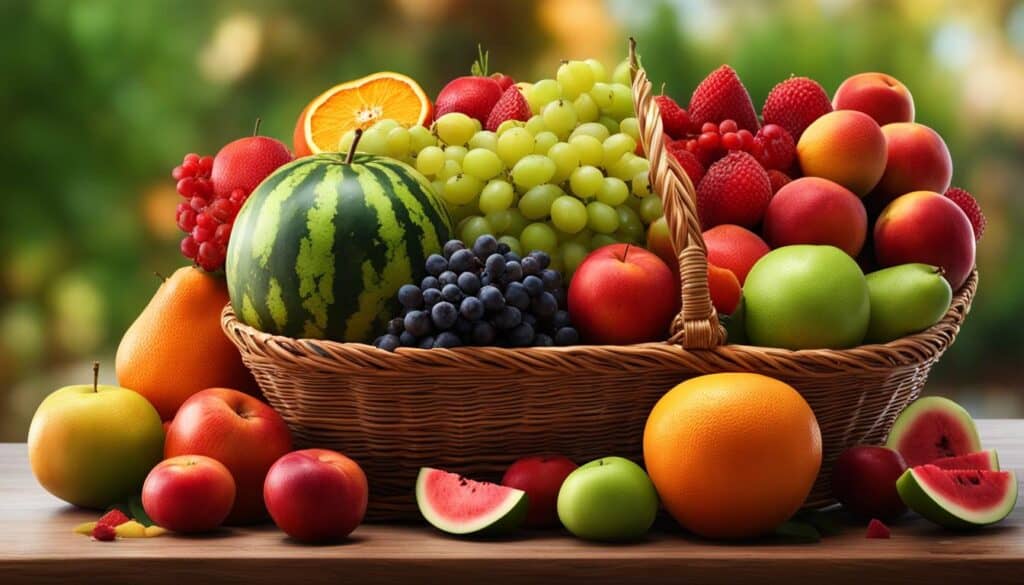
With these ideas and the right selection of seasonal fruits, you can create memorable and delicious dishes that will impress your friends and family during special occasions. Let the natural sweetness of the fruits elevate your celebrations and make them even more enjoyable!
Exploring Unique and Exotic Fruits
While many common fruits are available year-round, there are also unique and exotic fruits that have specific seasons. These specialty fruits offer interesting flavors and textures, adding excitement to your culinary adventures.
One such fruit is the persimmon, native to East Asia. It has a sweet and slightly tangy taste, and its texture can range from firm to custard-like when fully ripe. Persimmons are usually available in the fall and winter months and can be enjoyed fresh or used in various recipes.
Another exotic fruit worth exploring is the dragon fruit, which comes from several species of cactus native to the Americas and Southeast Asia. It has a vibrant pink or yellow skin with green scales and a white or red flesh speckled with tiny black seeds. Dragon fruit has a mildly sweet flavor and a refreshing, juicy texture. It is commonly found during the summer months and makes a visually stunning addition to fruit salads or smoothie bowls.
For a tropical twist, consider trying the passion fruit. This fruit comes from the passionflower plant and is known for its aromatic fragrance and tangy, tropical flavor. Passion fruit has a thick, wrinkled purple or yellow skin, and its inner pulp is filled with black seeds surrounded by a gel-like juice. It is most abundant in the summer and is perfect for adding a burst of tropical flavor to desserts or as a tangy topping for yogurt or ice cream.
So, when these specialty fruits are in season, take the opportunity to explore their unique flavors and textures. They can elevate your culinary experiences and introduce you to a whole new world of fruit delights.
Here’s a table highlighting some specialty fruits and their seasons:
| Fruit | Season |
|---|---|
| Persimmon | Fall and Winter |
| Dragon Fruit | Summer |
| Passion Fruit | Summer |
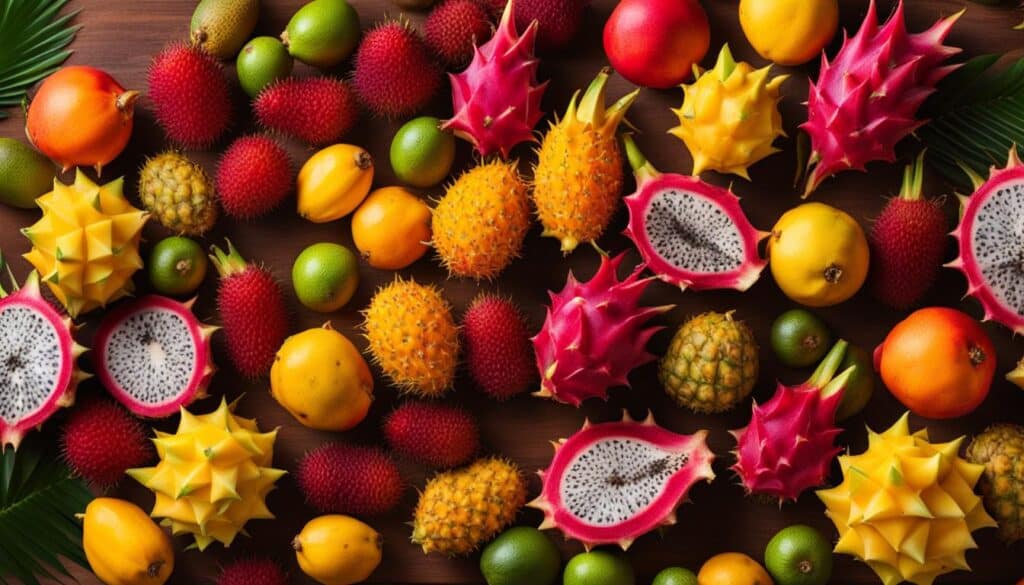
Local Seasonal Produce
The concept of eating seasonal fruits extends beyond just knowing what fruits are available when. It also involves supporting local farmers and the farm-to-table movement. By buying locally grown and sourced fruits, you not only get the freshest produce but also contribute to the sustainability of your local agricultural community.
When you choose to buy local fruits and vegetables, you support the farmers in your area who work hard to grow and harvest these delicious and nutritious foods. Local produce is often picked at its peak ripeness, which means it’s bursting with flavor and packed with nutrients. By purchasing from local farmers, you can enjoy the freshest and tastiest fruits available.
Furthermore, buying local fruits helps reduce the carbon footprint associated with long-distance transportation. When you purchase fruits that are grown nearby, the distance traveled from farm to table is often shorter, resulting in fewer greenhouse gas emissions and less energy consumption.
The farm-to-table movement emphasizes the importance of knowing where your food comes from and supporting local agriculture. By buying local fruits, you can connect with your community and build relationships with the farmers who grow your food.
Another advantage of buying local fruits is the economic benefit it provides to your community. When you support local farmers, you contribute to the local economy and help create jobs in the agricultural sector. This also ensures the preservation of farmland and the continuation of farming traditions in your region.
So, when you’re planning your meals and shopping for fruits, consider checking out your local farmers’ markets, farm stands, or community-supported agriculture (CSA) programs. These sources often offer a wide variety of seasonal fruits and vegetables that are grown nearby, making it easier for you to enjoy the freshest produce while supporting your local farmers and the farm-to-table movement.
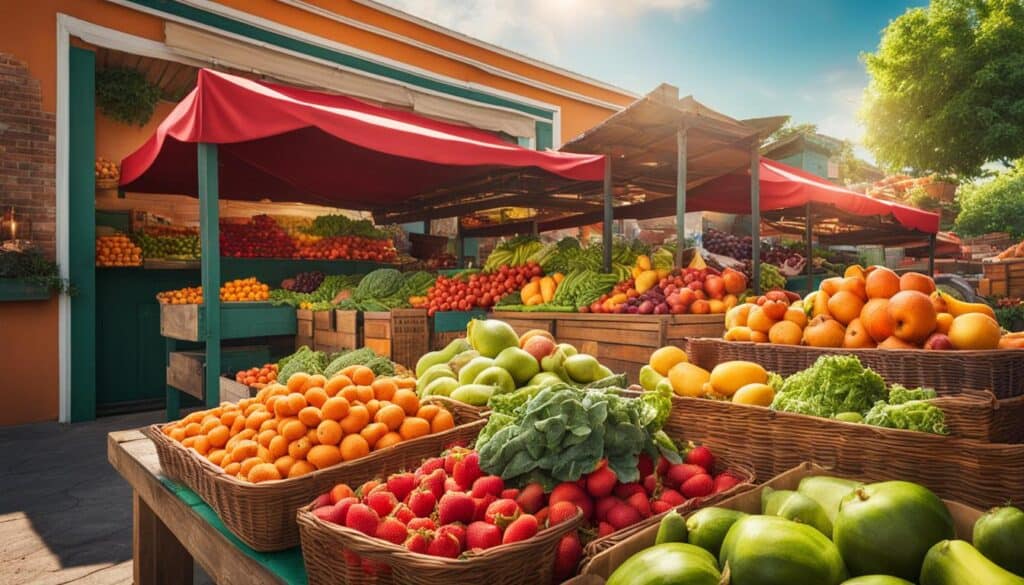
Conclusion
By using a when fruits are in season chart or fruit season calendar, you can make informed choices about the best times to buy and enjoy various fruits. This knowledge allows you to savor the freshest and most flavorful produce that each season has to offer. Additionally, sourcing your fruits locally not only ensures their freshness but also supports the hardworking growers in your community.
With an understanding of fruit availability by season, you can easily incorporate seasonal fruits into your diet and reap their numerous benefits. Seasonal fruits are not only packed with nutrients, but they also contribute to a balanced and diverse eating plan. By embracing the variety that each season brings, you can enjoy a wide range of flavors, textures, and culinary experiences.
Whether you choose to enjoy seasonal fruits as a refreshing snack, a colorful addition to your meals, or a thoughtful gift for special occasions, the when fruits are in season chart and fruit season calendar are valuable tools to have. Stay connected to the natural rhythm of the seasons and explore the unique tastes and combinations that await you throughout the year.
FAQ
How can knowing when fruits are in season be beneficial?
Knowing when fruits are in season allows you to enjoy the freshest and most flavorful produce. It also helps support local farmers and reduces the environmental impact of transportation. Buying locally sourced fruits is often more affordable and has a smaller carbon footprint.
Why is eating seasonal fruits beneficial?
Eating seasonal fruits allows you to enjoy them at their peak flavor and nutritional value. Seasonal fruits are also usually more affordable and abundant, making them accessible to everyone. Additionally, eating fruits that are in season can help support local farmers and reduce the environmental impact of transportation.
Which fruits are in season during each month of the year?
Different fruits are in season during different months of the year. Citrus fruits like oranges and lemons are available in winter, berries and stone fruits like strawberries and peaches are abundant in summer, while apples and pears are harvested in the fall. Refer to a fruit seasonality chart or fruit harvest calendar for more specific information.
How can I incorporate seasonal fruits into my diet?
Seasonal fruits can be enjoyed on their own as a healthy snack or incorporated into various recipes. You can add berries to your morning cereal or yogurt, use sliced apples or pears in salads, or make fruit-infused water for a refreshing drink. A seasonal fruits and vegetables chart can provide ideas on fruit and vegetable pairings that work well together.
What should I look for when shopping for seasonal fruits?
When shopping for seasonal fruits, look for fruits that are firm, vibrant in color, and have a pleasant aroma. Avoid fruits that are bruised, overly soft, or have mold spots. If possible, buy from local farmers’ markets or grocery stores that label the source of their produce for the freshest and most locally sourced fruits available.
How can I enjoy seasonal fruits all year round?
To enjoy seasonal fruits throughout the year, you can preserve them by freezing or canning. Freezing berries, sliced fruits, and citrus zest allows you to enjoy them in smoothies, baked goods, or as toppings. Canning fruits like peaches or apples can provide you with delicious homemade jams and preserves to enjoy throughout the year.
How can seasonal fruits enhance special occasions?
Seasonal fruits can add a festive touch to holidays and special occasions. For example, watermelons and berries are perfect for summer picnics, while apples and pears are great for fall-inspired desserts. Consider creating fruit gift baskets with seasonal fruits as a thoughtful and healthy gift option.
What are some unique and exotic seasonal fruits to explore?
There are unique and exotic fruits that have specific seasons. Specialty fruits like persimmons, dragon fruit, or passion fruit offer interesting flavors and textures. Take the opportunity to explore these fruits when they are in season to expand your culinary experiences and try something new.
How does eating local seasonal produce contribute to the farm-to-table movement?
Buying locally grown and sourced fruits not only provides you with the freshest produce but also supports the sustainability of your local agricultural community. By choosing locally sourced fruits, you contribute to the farm-to-table movement, which promotes a closer connection between farmers and consumers.
How can I make informed choices about buying and enjoying seasonal fruits?
Use a when fruits are in season chart or fruit season calendar to determine the best times to buy and enjoy various fruits. Aim to source locally whenever possible to ensure freshness and support local growers. With this understanding, you can incorporate seasonal fruits into your diet, enjoy their flavors and nutritional benefits, and appreciate the variety that each season brings.

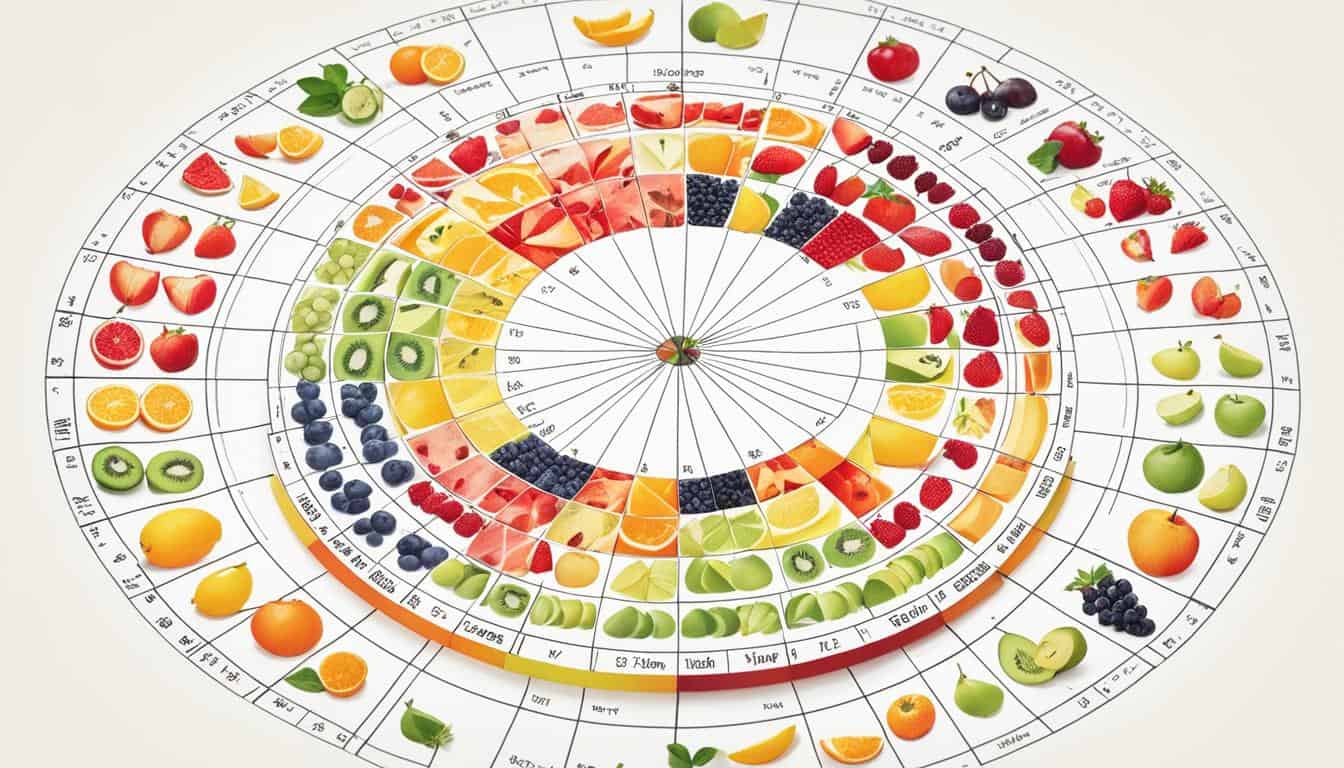



Leave a Reply